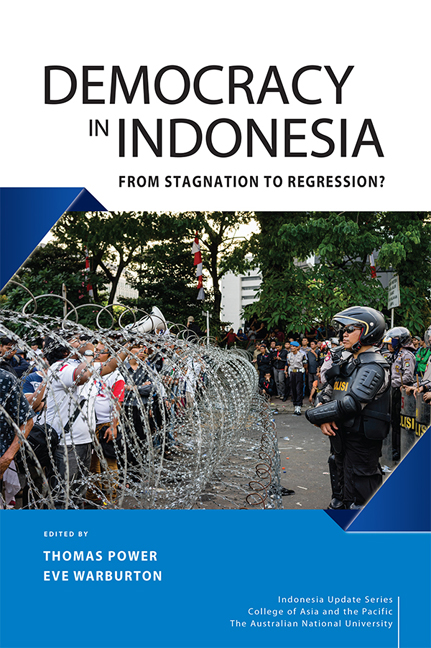Book contents
- Frontmatter
- Contents
- Tables and Figures
- Contributors
- Foreword
- Acknowledgments
- Glossary
- 1 The decline of Indonesian Democracy
- Part 1 Historic al and Comparative Perspectives
- Part 2 Polarisation and Populism
- Part 3 Popular Supp ort for Democracy
- Part 4 Democratic Institutions
- Part 5 Law, Security and Disorder
- Index
- Indonesia Update Series
7 - Islamic populism and Indonesia’s illiberal democracy
Published online by Cambridge University Press: 24 November 2020
- Frontmatter
- Contents
- Tables and Figures
- Contributors
- Foreword
- Acknowledgments
- Glossary
- 1 The decline of Indonesian Democracy
- Part 1 Historic al and Comparative Perspectives
- Part 2 Polarisation and Populism
- Part 3 Popular Supp ort for Democracy
- Part 4 Democratic Institutions
- Part 5 Law, Security and Disorder
- Index
- Indonesia Update Series
Summary
As a variant of populist politics, Islamic populism is a response to disillusionment and grievance with the ruling elites that is made distinctive by the use of Islamic rhetoric. Such rhetoric can unite different and contradictory interests within the Muslim community, and forge cross-class alliances—even if such alliances are tenuous in nature (Hadiz 2016; Hadiz and Chryssogelos 2017; Robison and Hadiz 2020). In Indonesia, the phenomenon of Islamic populism found its most dramatic expression during the 2017 Jakarta gubernatorial election when hundreds of thousands of Muslims staged a series of mass rallies known as the Defence of Islam movement (Aksi Bela Islam) against incumbent Basuki Tjahaja Purnama, popularly known as Ahok, who was accused of blaspheming Islam. This movement not only helped defeat Ahok electorally, but it was also instrumental in ensuring Ahok was charged with blasphemy and subsequently jailed, thereby paving the way for the use of Islamic populist narratives in a number of other political contests, including the 2019 presidential election.
Some studies on Indonesian Islamic populism employ actor-centred analysis focusing on the style of populist actors and their effect on democratic quality (Aspinall and Warburton 2018; Lindsey 2017; Mietzner 2018; Power 2018). Others utilise cultural-oriented analysis, explaining Islamic populist mobilisation as a result of increasing intolerance (Arifianto 2019; Assyaukanie 2017; Nuraniyah 2018). While both forms of analyses contribute to understanding facets of the Islamic populist phenomenon, they overlook the structural conditions linked to the broader prevalence of illiberal politics and to the kinds of social bases that make possible the rise of populist politics in the first place. According to Robison and Hadiz (2020), varieties of populist politics, including Islamic populism, ‘must be understood in the context of widespread failure of governments and elites to deal with larger structural crises that threaten their societies and with the disruption of old class or patronage-based politics by the rise of new cross class alliances’. Without attention to these sorts of structural forces, analyses tend to lead to over-anxiety about Islamist threats. Such analyses have also led to the view employed by the Indonesian government to justify its own form of reactionary populist politics. In this chapter I develop three main arguments on the basis of such observations.
- Type
- Chapter
- Information
- Democracy in IndonesiaFrom Stagnation to Regression?, pp. 118 - 138Publisher: ISEAS–Yusof Ishak InstitutePrint publication year: 2020

